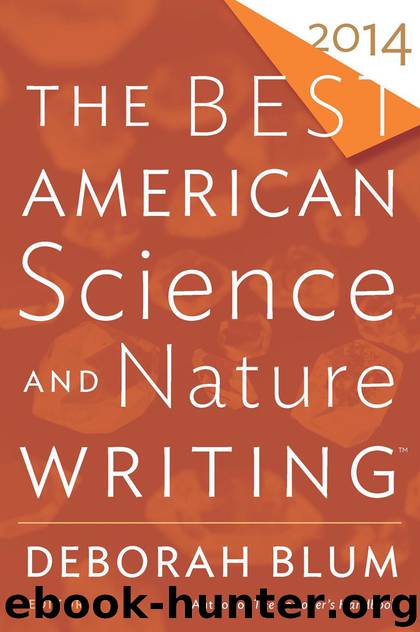The Best American Science and Nature Writing 2014 by Deborah Blum

Author:Deborah Blum [Blum, Deborah]
Language: eng
Format: epub, mobi
Publisher: Houghton Mifflin Harcourt
Published: 0101-01-01T00:00:00+00:00
II
The Geological Society of London, known to its members as the Geol Soc (pronounced “gee-ahl sock”), was founded in 1807, over dinner in a Covent Garden tavern. Geology was at that point a brand-new science, a circumstance reflected in the society’s goals, which were to stimulate “zeal” for the discipline and to induce participants “to adopt one nomenclature.” There followed long, often spirited debates on matters such as where to fix the borders of the Devonian period. “Though I don’t much care for geology,” one visitor to the society’s early meetings noted, “I do like to see the fellows fight.”
The Geol Soc is now headquartered in a stone mansion not far from Piccadilly Circus. On the outside the style of the mansion is Palladian; inside, it leans more toward midcentury public library. Much of the place is wrapped in plastic, owing to a construction project that never quite seems to reach completion. Near the reception desk, behind a green velvet curtain, hangs a copy of the first geological map of Britain, which was published in 1815 by William Smith. (Smith’s British biographer has called the map “one of the classics of English science”; his American counterpart has pronounced it “the map that changed the world.”) At the top of the stairs, there’s a reading room with a brass chandelier, a few armchairs, some scuffed tables, and a broken coffee machine.
On a sunny morning not long ago, Jan Zalasiewicz, a stratigrapher and longtime society member, was sitting in the reading room, wishing the coffee machine were functional so that he could make a cup of tea. Zalasiewicz is a slight, almost elfin man with shaggy graying hair and narrow blue eyes. He had come down to London that morning from his home in Nottinghamshire to give a visitor a tour. His perspective on the Geol Soc, and on the city more generally, was, he had to admit, idiosyncratic.
“This building has never been considered as a rock before,” he observed. “But it is just as much made of geology as anything you would find out in the field.
“Clearly, very few of these objects will survive Pompeii style,” he went on, gesturing, with a faraway look in his eyes, toward the chairs, the tables, the magazine racks, and the coffee machine. “But they won’t simply disappear. They’ll break down into rubble, and the rubble will be washed away. But even the rubble that’s been washed away will have its own character, its own signal.” He swiveled to take in the windows (mostly silica) and the paneling (made of wood). “Potentially, everything here is fossilizable,” he said.
Walter White–like, Zalasiewicz leads a double life. By day he’s an expert on a group of ancient marine organisms known as graptolites. Zalasiewicz deeply admires graptolites, which thrived and diversified in the early Paleozoic, some 500 million years ago, only to be very nearly wiped out in a catastrophic extinction event. Present him with a fossilized graptolite and he can tell you at a glance which biozone of the Silurian period it belongs to.
Download
The Best American Science and Nature Writing 2014 by Deborah Blum.mobi
This site does not store any files on its server. We only index and link to content provided by other sites. Please contact the content providers to delete copyright contents if any and email us, we'll remove relevant links or contents immediately.
The Lonely City by Olivia Laing(4555)
Animal Frequency by Melissa Alvarez(4140)
All Creatures Great and Small by James Herriot(3970)
Walking by Henry David Thoreau(3672)
Exit West by Mohsin Hamid(3625)
Origin Story: A Big History of Everything by David Christian(3461)
COSMOS by Carl Sagan(3334)
How to Read Water: Clues and Patterns from Puddles to the Sea (Natural Navigation) by Tristan Gooley(3221)
The Inner Life of Animals by Peter Wohlleben(3094)
How to Do Nothing by Jenny Odell(3091)
Hedgerow by John Wright(3081)
How to Read Nature by Tristan Gooley(3066)
Project Animal Farm: An Accidental Journey into the Secret World of Farming and the Truth About Our Food by Sonia Faruqi(3002)
Origin Story by David Christian(2980)
Water by Ian Miller(2945)
A Forest Journey by John Perlin(2898)
The Plant Messiah by Carlos Magdalena(2740)
A Wilder Time by William E. Glassley(2682)
Forests: A Very Short Introduction by Jaboury Ghazoul(2664)
